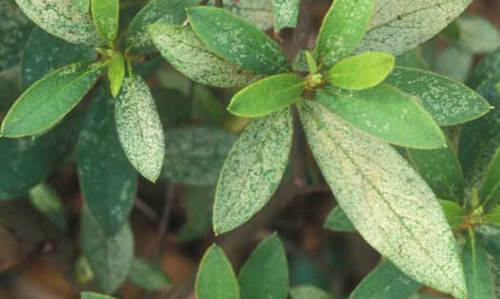
by Sheila Dunning | Aug 7, 2019
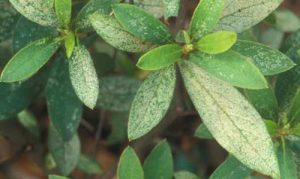
Damage caused by azalea lace bug, Stephanitis pyrioides (Scott), feeding. Photograph by James. L. Castner, University of Florida. Severely damaged leaves become heavily discolored and eventually dry or fall off. Symptoms may sometimes be confused with mite injury, but the presence of black varnish-like excrement, frequently with cast skins attached, suggest lace bug damage (Johnson and Lyon 1991).
You may be noticing the color disappearing from your azaleas right now. Do your azaleas look bleached out from a piercing-sucking insect. The culprit is probably azalea lace bug, Stephanitis pyrioides. This pest overwinters in eggs on the underside of infested leaves. Eggs hatch in late March and early April. The insect then passes through five nymphal instars before becoming an adult. It takes approximately one month for the insect to complete development from egg to adult and there are at least four generations per year. Valuable plants that are susceptible to lace bug damage should be inspected in the early spring for the presence of overwintering lace bug adults, eggs and newly-hatched nymphs. Inspect these plants every two weeks during the growing season for developing lace bug infestations.
Both adults and nymphs have piercing-sucking mouthparts and remove sap as they feed from the underside of the leaf. Lace bug damage to foliage detracts greatly from the plant’s beauty, reduces the plant’s ability to produce food, decreases plant vigor and causes the plant to be more susceptible to damage by other insects, diseases or unfavorable weather conditions. The azalea can become almost silver or bleached in appearance from the feeding lace bug damage.
However, lace bugs often go undetected until the infested plants show severe damage sometime into the summer. By then several generations of lace bugs have been weakening the plant. Inspecting early in the spring and simply washing them off the underside of the leaves can help to avoid damage later and the need for pesticides.
Adult lace bugs are flattened and rectangular in shape measuring 1/8 to 1/4 inch long. The area behind the head and the wing covers form a broadened, lace-like body covering. The wings are light amber to transparent in color. Lace bugs leave behind spiny black spots of frass (excrement).
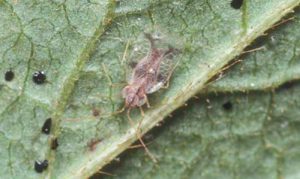
Adult azalea lace bug, Stephanitis pyrioides (Scott), and excrement. Photograph by James. L. Castner, University of Florida.
Lace bug nymphs are flat and oval in shape with spines projecting from their bodies in all directions. A lace bug nymph goes through five growth stages (instars) before becoming an adult. At each stage the nymph sheds its skin (molts) and these old skins often remain attached to the lower surface of infested leaves.
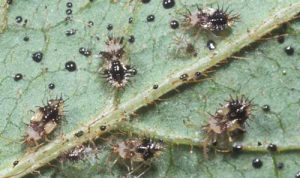
Nymphs of the azalea lace bug, Stephanitis pyrioides (Scott), with several cast skins and excrement. Photograph by James. L. Castner, University of Florida.
Azalea lace bug eggs are football-shaped and are transparent to cream colored. Lace bug eggs are found on the lower leaf surface, usually alongside or inserted into a leaf vein. Adult females secrete a varnish-like substance over the eggs that hardens into a scab-like protective covering.
Other plant species, such as lantana and sycamore, may have similar symptoms. But, realize that lace bugs are host specific. They feed on their favorite plant and won’t go to another plant species. However, the life cycle is similar. Be sure to clean up all the damaged leaves. That’s where the eggs will remain for the winter. Start next spring egg-free.
For more information go to: http://entomology.ifas.ufl.edu/creatures/orn/shrubs/azalea_lace_bug.htm
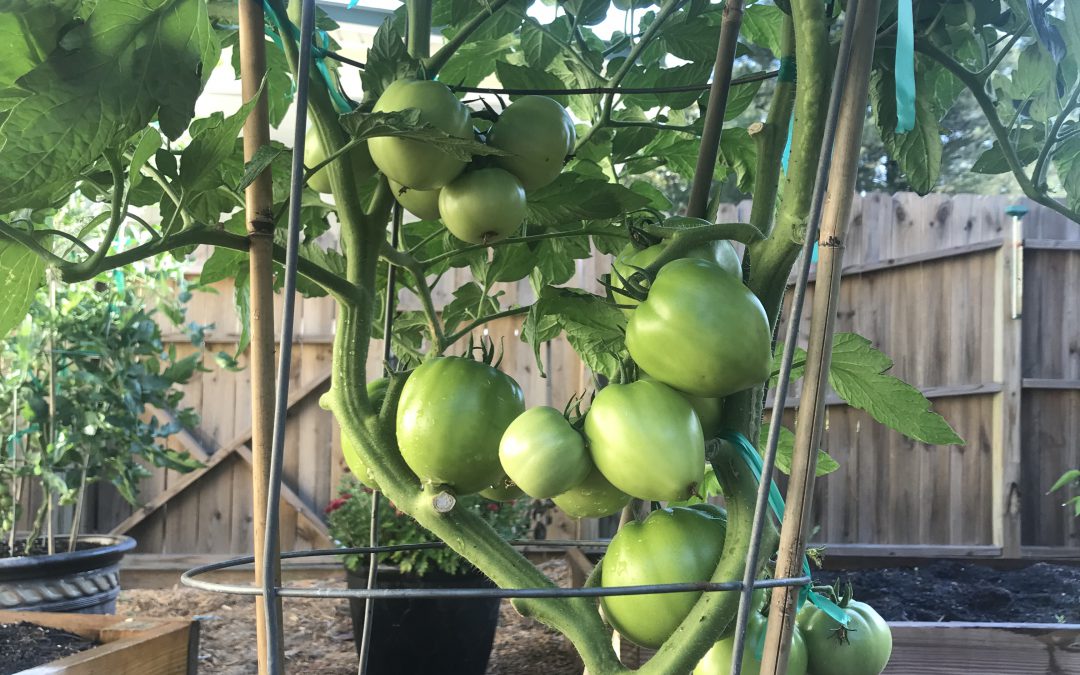
by Daniel J. Leonard | May 27, 2019
Talk to nearly any Panhandle gardener and one of the first things brought up in conversation is the difficulty growing large, beefsteak/slicing tomatoes (Solanum lycopersicum) in their home garden. Large tomatoes are indeed among the more challenging garden vegetables in North Florida, affected by myriad pests, pathogens and abiotic issues. However, giving up growing this garden favorite is unwarranted as success can be had by following a couple of often overlooked, simple steps to ward off potential problems.
Choose Resistant Cultivars – One of the major recent gardening trends is the rise of heirloom veggies, particularly heirloom tomatoes. While many of these varieties certainly are interesting and often possess superior flavor/texture, heirlooms are, as a group, extraordinarily susceptible to disease in our climate. Fortunately for gardeners, there are a number of excellent varieties available with large resistance profiles to many common diseases and a similar taste profile to heirloom favorites! ‘Big Beef’ (pictured), ‘Better Boy’, ‘Celebrity’, and ‘Skyway’ are just a few of the many great cultivars with extensive disease resistance available as transplants at garden centers or as seed from quality online seed vendors.
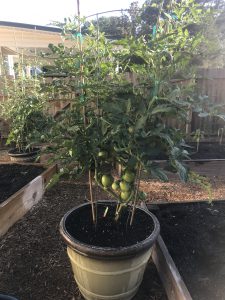
Tomato ‘Big Beef’ in 15 gallon decorative container
Start Early – Once, you’ve selected the proper cultivar, the next key is to get them in the ground early! I’m convinced one of the primary reasons folks fail with tomatoes is waiting for “traditional” garden planting dates. For instance, an old tradition in the South is to plant your garden on Good Friday before Easter. However, according to Johnny’s Selected Seeds Southeast Sales Representative Blake Thaxton, tomatoes should be germinated and growing in the garden no later than March 15. Mr. Thaxton notes two primary reasons for this, the most important being pest/disease avoidance. Beefsteak tomato varieties take around 70 days from planting to harvest, so a March 15th planting date yields ripe tomatoes around the third or fourth week of May, when pest/disease pressure is still manageable. Pests and disease occurrence becomes exponentially worse in the Panhandle as May trickles into June and July, therefore it is critical that your fruit begin ripening prior to this onslaught. An important second motivation to plant early is that tomatoes stop setting fruit when nighttime temperatures rise above 75°F. At these temperatures, tomato pollen is rendered sterile and though the plant will continue flowering, no fruit will be set.
Mulch – Another overlooked best management practice in backyard veggie gardening is mulching! Those of us who tend flower beds already know many benefits of mulch like soil temperature moderation, weed prevention, and moisture conservation. But for tomato growers, mulch has another benefit – disease prevention! Several serious diseases that affect tomato are soil-borne pathogens (i.e. Early Blight, Late Blight, Bacterial Spot, etc.). These pathogens find their way onto plants either indirectly via water splashing from soil onto leaves or direct contact from leaves and fruit resting on the soil. To prevent these pathogens from infecting plant tissue, apply an organic mulch (preferably wheat straw or tree leaves) under and around plants. This simple step goes a long way toward season-long, yield-saving disease prevention.
Consistent Watering – Everyone knows plants need water but what you might not know is that irrigation consistency makes a huge difference in plant health, particularly tomatoes. Consistent watering is key in helping ward off one of the most frustrating tomato maladies, blossom end rot (BER) – you know, the one where the bottom end of your perfectly good tomato fruit turns to a brownish mush! Though BER is caused by calcium deficiency, the condition is commonly induced by creation of distinct wet and dry periods from non-regular watering, interfering with calcium uptake and availability to the plant. So, while you may have adequate soil calcium, if you don’t water correctly, the condition will happen anyway! It’s also good to keep in mind that mature tomato plants use large quantities of water daily, so during the heat of summer, plants in containers may need to be watered multiple times daily to maintain consistently moist soil. Think about it, you don’t drink 8 glasses of water when you wake up and then never drink again throughout a hot day. A tomato is no different. Allowing your plants to wilt down before providing additional water ruins productivity and can induce BER.

Tomato ‘Big Beef’ demonstrating pruning for soil clearance and airflow.
Pruning – I get it. Once you’ve nursed your baby tomato from a wee transplant or seed into a rapidly growing and flowering plant, it seems counter-intuitive to break out the pruners, but to keep your tomato plant as healthy as possible for as long as possible, that is what you must do! Pruning tomatoes should accomplish two things. First, remove the bottom layer of foliage from the plant base, so that water will not readily splash onto the lowest remaining leaves. (I tend to remove all leaves up to the second set of flowers 8-12” from the soil’s surface.) As with mulching, this prevents bacterial and fungal pathogens from spreading easily from the soil surface onto your plant. Second, tomato plants, especially the vigorous indeterminate varieties, often grow more foliage than is necessary for fruit production. This excess foliage can prevent airflow and trap moisture in the canopy of the plant, promoting disease. To open up the canopy and allow for more airflow, I prune off leaves that grow from the primary stems inward to the center of the plant. The idea is to keep the inside of the plant open while allowing enough leaves to power photosynthesis and shade the developing fruit below.
Tomatoes are notoriously hard to grow, but by following a few easy preventative practices, gardeners can greatly increase their chances of realizing harvestable fruit come summer. Please keep in mind that this is not an exhaustive list that will ensure disease-free plants over the entire growing season (you should also get a soil test to make sure your pH and soil fertility are correct and ideally you’d never work in your tomatoes when they are wet, etc., but this is a good place to start!). However, a little bit of planning and prevention early in the season can make growing tomatoes a lot less frustrating! As always, if you have questions regarding tomatoes or any other horticultural topic, please contact your local UF/IFAS Extension Office. Happy gardening!
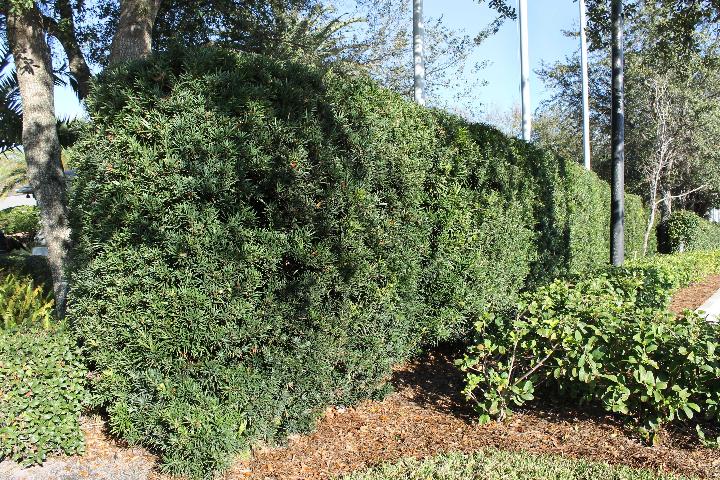
by Logan Boatwright | May 27, 2019
Everyone likes their privacy. Usually, a large eight-foot privacy fence is built for that reason. That option tends to be expensive. What is a different approach for a similar result? A natural wall!
One advantage of having a natural wall is that a homeowner has options when choosing plants. When it comes to choosing plants for a natural wall, the first thing to decide is if a wall needs to be year round or seasonal. Size would be the next factor to determine.
Japanese Cedar (Cryptomeria japonica) has the capability of growing 40 to 60 feet in height and 15 to 20 feet in width. There are some smaller varieties to pick from, but where is the fun in having a small wall?
Another plant option that would require pruning, but make an excellent natural wall is Japanese Yew (Podocarpus macrophyllus). This specimen will grow 30 to 40 feet tall and 20 to 25 feet in width if left unpruned, however, it is a slow grower. Yaupon Holly (Ilex vomitoria) comes in several selections of various sizes so the height range is 3 to 20 feet. The width range is 5 to 15 feet.
The Emerald Green Arborvitae is a fast grower that would be ideal for the homeowner who does not want a tall wall. It keeps a tight pyramid shape that will reach heights up 12 to 14 feet and needs 4 to 6 feet of space. Green Giant Arborvitae or Thuja Giant (Thuja standishii x plicata ‘Gre) is an excellent tree to pick for a natural wall. It has the capability to reach 50 to 60 feet in height and spreads out 12 to 20 feet at maturity. This arborvitae is considered to be a fast grower since it can increase more than 24” per year.
The larger selections of Loropetalum are other shrubs that homeowners have used to establish their privacy wall. One can expect a height up to 15 feet if left unpruned and pinkish to purple strap-like flowers, which makes for a great wall height.
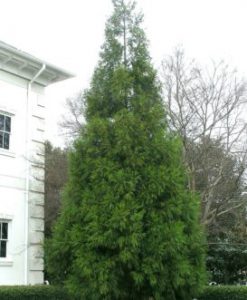
‘Yoshino’ Japanese cryptomeria
Photo by Karen Russ, ©HGIC, Clemson Extension
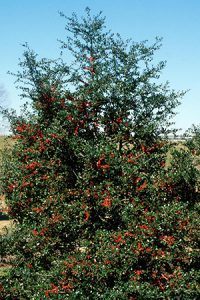
A yaupon holly cultivar (Ilex vomitoria ‘Roundleaf’). John Ruter, University of Georgia, Bugwood.org Creative commons license.
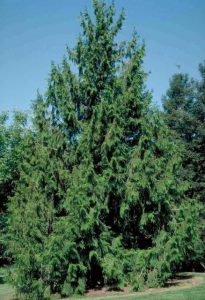
Thuja plicata: Giant Arborvitae. Credit: Ed Gilman, UF/IFAS
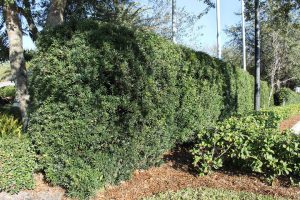
Podocarpus macrophyllus or Japanese Yew. Credit: UF/IFAS
These plants are some of the selections homeowners may choose to start their natural walls. Given time, these shrubs will develop into a dense screen for the interruption of unwanted light or noise. To learn more about the aforementioned plant material, contact your local UF / IFAS extension agent.
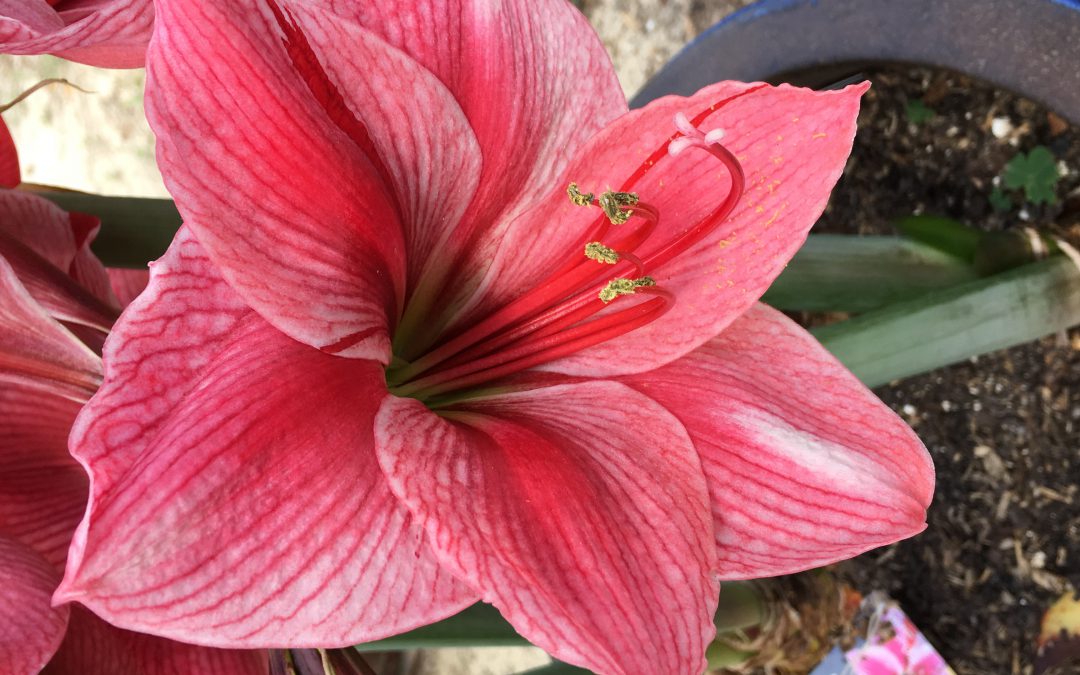
by Logan Boatwright | Apr 16, 2019
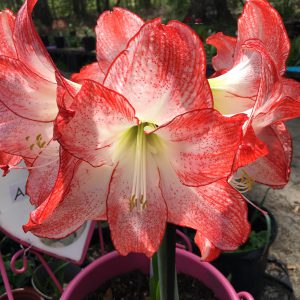
Blooming amaryllis flower. Photo by Logan Boatwright
Are you tired of seeing only green from your shrubs such as boxwood or yew? Are the areas next to your home walls, fences, terraces, tree islands, gate entrances, and/or borders barren? Do you want to add color to these areas? You may want to consider planting these areas with the beautiful amaryllis (Hippeastrum x hybridum).
Amaryllis grows from a tough, dependable bulb that will bloom during the spring after winter dormancy. The strap-shaped leaves will emerge first and grow about 1.5 inches wide, up to three feet long, and persist much of the year in Florida. They are reduced later in the summer and ultimately die back from frost.
In the late winter, bulbs will eventually produce one to three leafless stalks, or scapes, that will each have two or more trumpet-shaped flowers. Flowers come in a variety of forms and shapes: from single and double, miniature or large. Flower colors can be red, bright pink, shades of pink, orange, white, rose, or even salmon. It does not stop there! The flowers may even be striped and multi-colored. Amaryllis can create a striking focal point when they are planted in clusters of 10 or more of similar color.
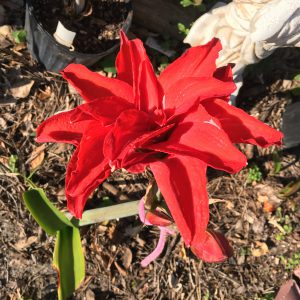
Double flowers of amaryllis. Photo by Logan Boatwright.
Amaryllis may be planted anytime of the year, but winter is best. They are sun- and shade-tolerant, but planting in light shade is best since leaves will yellow in full sun and plants bloom poorly in heavy shade. Amaryllis prefer well-drained sites to prevent bulb and root rots.
For the best amaryllis performance, till and amend the soil with a 3- to 4-inch layer of organic matter and 2 to 3 pounds of 6-6-6, or a comparable amount of other complete fertilizer per 100 square feet. Plant 12 to 15 inches apart. Amaryllis can greatly benefit from at least one fertilizer application in the early spring and two to three applications during the growing season.
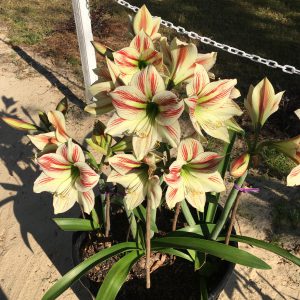
Many blooms from multiple amaryllis bulbs. Photo by Logan Boatwright.
After flowering it’s a good practice to remove the stalks, unless seeds for planting are desired. If the bulbs become crowded, dig and separate them out. Doing this will encourage large, uniform flowers.
Go out, plant a few amaryllis plants today, and be ready to. To learn more about Amaryllis, please follow this link.
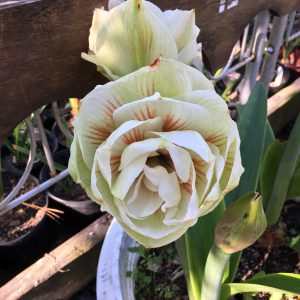
Blooming amaryllis plant. Photo by Logan Boatwright.

by Logan Boatwright | Mar 26, 2019
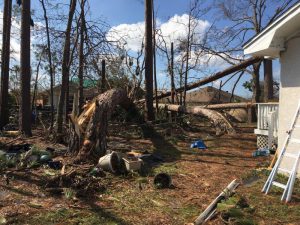
Hurricane Michael Damage – Photo Credit Larry Williams
The aftermath of Hurricane Michael has many homeowners preparing their landscapes for the upcoming season. Several have called the office in need of a home visit because they want ideas of what to replant with and how to kill the weeds that have popped up. One common question is, “What trees can I plant that are fast growing and has plenty of shade?” Before I answer their question, I ask them, “Are you planning for future storms or not?”
Trees that are considered ‘fast’ growing are not necessarily the best choice for future storms. Many of the fast growing trees can be easily uprooted, break easily in strong winds, are more prone to decay, and/or are rather short-lived (<50 years old). Additionally, a missing structural pruning plan for young and mature trees will increase the chances of fallen trees. Homeowners can expect to replant trees once again if these characteristics are likely. Keep in mind that no tree is absolutely wind-proof since other factors need to be ideal for wind-resistance. Trees like laurel oak (Quercus laurifolia), water oak (Quercus nigra), cherry laurel (Prunus caroliniana), bradford pear (Pyrus calleryana), and pecan (Carya illinoensis) are some to be cautious of when replanting for wind resistance.
A few tips for homeowners re-planting hurricane damaged trees:
- Plant trees with higher wind resistance in groups with adequate soil space and soil properties.
- Prevent damage to the roots.
- Have a variety of native species, ages, and layers of high-quality trees and shrubs.
- Some of the best trees a homeowner should consider replanting with could be live oak (Quercus virginiana), southern magnolia (Magnolia grandiflora), baldcypress (Taxodium distichum), river birch (Betula nigra), and Japanese maple (Acer palmatum). A more in-depth look at wind resistant trees can be found by reading Wind and Trees: Lessons Learned from Hurricanes.FOR 118
.



















